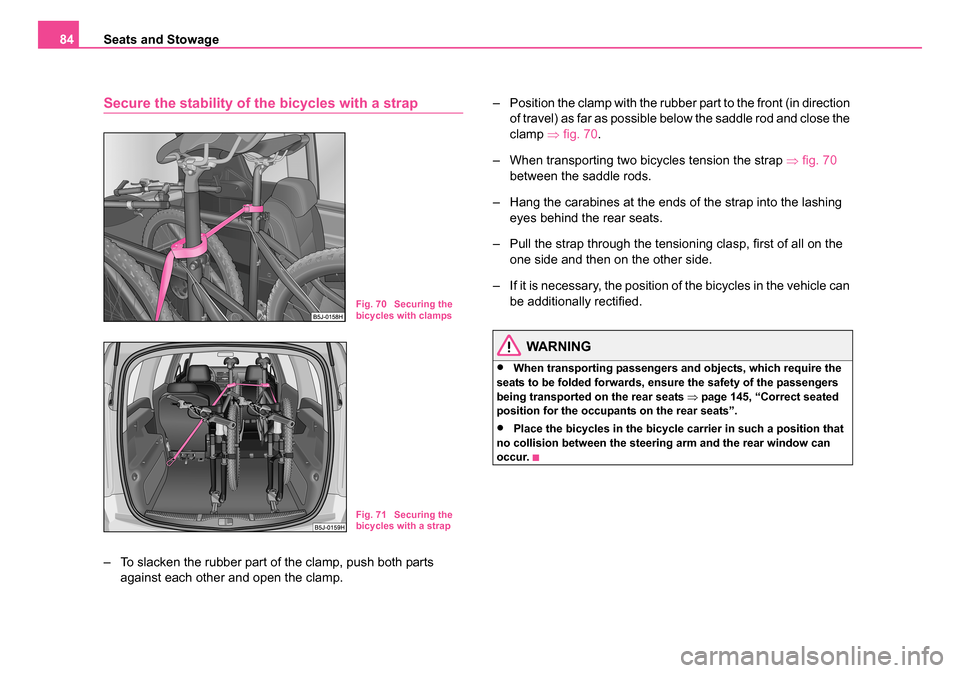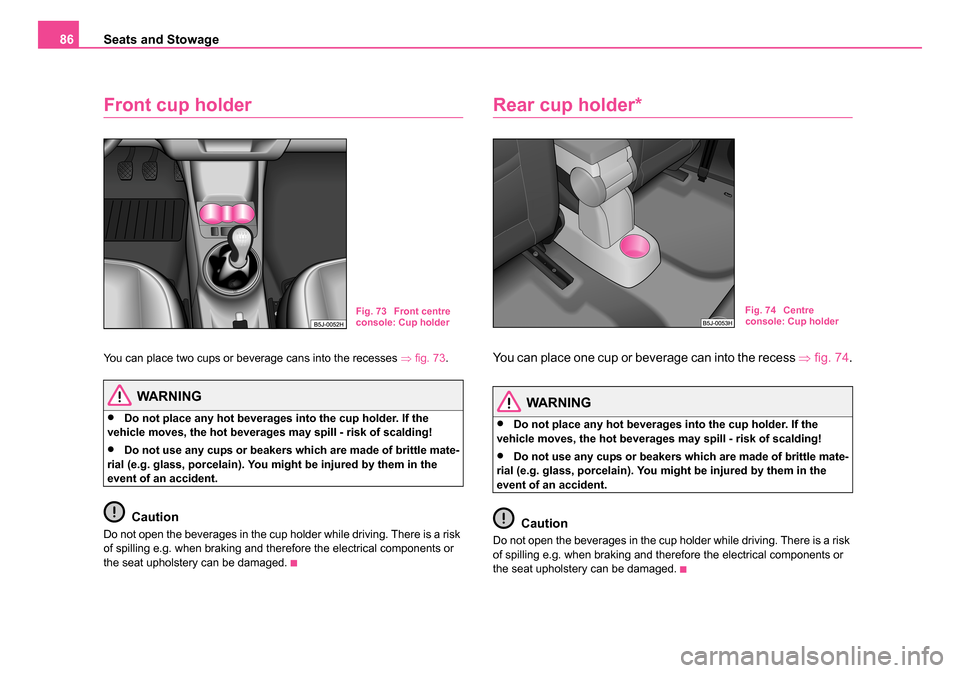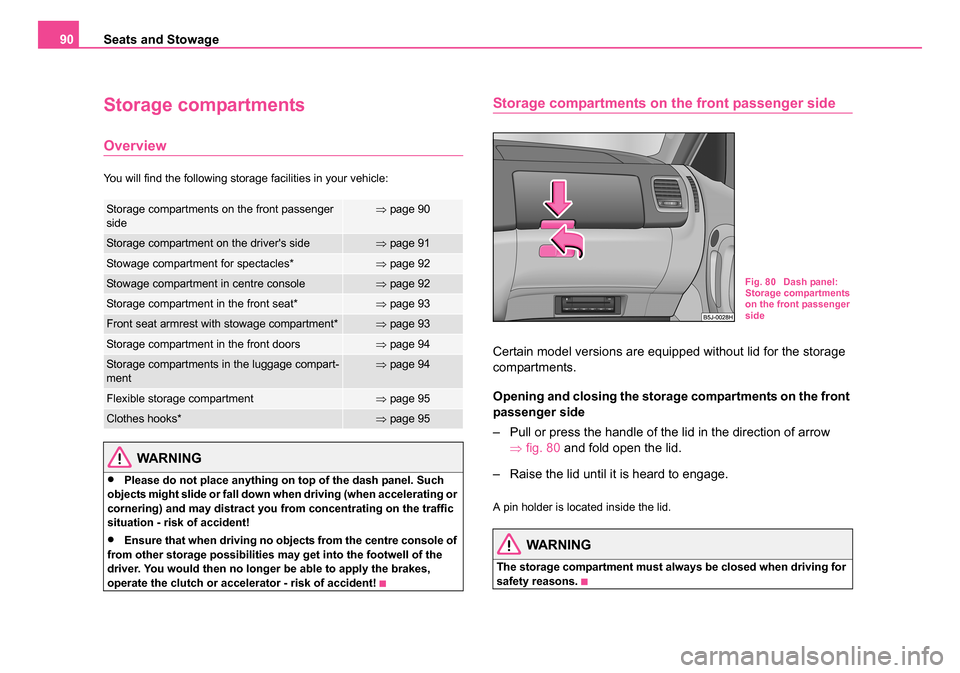Page 82 of 274

Seats and Stowage81
Using the systemSafetyDriving TipsGeneral MaintenanceBreakdown assistanceTechnical Data
WARNING
No objects should be placed on the luggage compartment cover,
the vehicle occupants could be endangered if there is sudden
braking or the vehicle co llides with something.
Caution
Please ensure that the heating elements of the rear window heater are not
damaged as a result of objects placed in this area.
Note
When opening the tailgate, lift the luggage compartment cover - risk that
objects placed in this area can slip forward!
Bicycle carrier*
Install cross member
– Remove the rear seats or fold the seats fully forwards, in order
to make available the necessary space in the luggage
compartment ⇒page 74.
– Release the fixture at the ends of the cross member by slightly pulling up the securing screw .
– Position the cross member with the fixed part onto the right (in direction of travel) lashing eye and then the pull out part
onto the left lashing eye.
– Secure the fixture to both sides and lock the fixing screws in place.
– Tighten the fixing screws up to the stop.
Fig. 66 Install cross
member
AB
AC
AA
AB
AC
AC
NKO 20 A05.book Page 81 Wednesday, June 21, 2006 1:42 PM
Page 83 of 274
Seats and Stowage
82
– Check the attachment of the cross member by pulling it.
WARNING
When transporting the bicycles in the luggage compartment,
ensure the safety of the passengers transported on the rear seats
⇒page 145, “Correct seated position for the occupants on the rear
seats”.
Install bicycle carrier
– Position the approved bicycle carrier on the cross member, after pulling up the screw push the frame side rail (alu-
part) towards the cross member and screw the screw into
the nut ⇒fig. 67 . – Slacken the screw on the moveable part of the bicycle
carrier and pull out, then position the moveable part of the
carrier, depending on bicycle size, into one of the three
possible positions.
– Insert the screw into the desired position and tighten.
Fig. 67 Install bicycle
carrier
AA
AA
AB
AB
NKO 20 A05.book Page 82 Wednesday, June 21, 2006 1:42 PM
Page 85 of 274

Seats and Stowage
84
Secure the stability of the bicycles with a strap
– To slacken the rubber part of the clamp, push both parts
against each other and open the clamp. – Position the clamp with the rubber part to the front (in direction
of travel) as far as possible below the saddle rod and close the
clamp ⇒fig. 70 .
– When transporting two bicycles tension the strap ⇒fig. 70
between the saddle rods.
– Hang the carabines at the ends of the strap into the lashing eyes behind the rear seats.
– Pull the strap through the tensioning clasp, first of all on the one side and then on the other side.
– If it is necessary, the position of the bicycles in the vehicle can be additionally rectified.
WARNING
•When transporting passengers and objects, which require the
seats to be folded forwards, ensure the safety of the passengers
being transported on the rear seats ⇒page 145, “Correct seated
position for the occupants on the rear seats”.
•Place the bicycles in the bicycle carrier in such a position that
no collision between the steering arm and the rear window can
occur.
Fig. 70 Securing the
bicycles with clamps
Fig. 71 Securing the
bicycles with a strap
NKO 20 A05.book Page 84 Wednesday, June 21, 2006 1:42 PM
Page 86 of 274

Seats and Stowage85
Using the systemSafetyDriving TipsGeneral MaintenanceBreakdown assistanceTechnical Data
The roof luggage rack system*
Roof rail*
Pay attention to the following points if you wish to transport luggage or
other items on the roof of your vehicle:
•A special roof luggage rack system was developed for the vehicle, that
is why you should only use a roof luggage rack which has been released
for use by Škoda Auto a.s.
•The roof rail is the basis for a complete roof luggage rack system.
Separate additional holders are required for safety reasons for trans-
porting luggage, bikes, surfboards, skis and boats.
•The basic version of the roof luggage rack system and further compo-
nents are obtainable as accessories from Škoda Service Partners.
Caution
•Ensure that the opened tailgate does not collide with the roof load.
For the sake of the environment
The increased aerodynamic drag results in a higher fuel consumption.
Note
A roof rail is obtainable from a Skoda Service Partner if hasn't been fitted
onto a vehicle at the works.
Roof load
Distribute weight evenly over the roof luggage rack system. The maximum
permissible roof load (including roof rack system) of 75 kg and the
maximum permissible total weight of the vehicle should not be exceeded.
You cannot make full use of the permissible roof load if you use a roof
luggage rack system with a lower load carrying capacity. The load trans-
ported on the roof luggage rack system must not exceed the weight limit
which is stated in the fitting instructions.
WARNING
•The items which you transport on the roof bar system must be
reliably attached - risk of accident!
•You must on no account exceed the permissible roof load, the
permissible axle loads and the permissible gross weight of your
vehicle - risk of accident!
•Please note that the handling properties of your vehicle change
when you transport heavy or bulky items on the roof bar system as
a result of the displacement of the centre of gravity and the
increased wind attack area - risk of accident! You must absolutely
adapt your style of driving and the speed of the vehicle to the
specific circumstances.
Fig. 72 Roof rail
NKO 20 A05.book Page 85 Wednesday, June 21, 2006 1:42 PM
Page 87 of 274

Seats and Stowage
86
Front cup holder
You can place two cups or beverage cans into the recesses ⇒fig. 73 .
WARNING
•Do not place any hot beverages into the cup holder. If the
vehicle moves, the hot beverages may spill - risk of scalding!
•Do not use any cups or beakers which are made of brittle mate-
rial (e.g. glass, porcelain). You might be injured by them in the
event of an accident.
Caution
Do not open the beverages in the cup holder while driving. There is a risk
of spilling e.g. when braking and therefore the electrical components or
the seat upholstery can be damaged.
Rear cup holder*
You can place one cup or beverage can into the recess ⇒fig. 74 .
WARNING
•Do not place any hot beverages into the cup holder. If the
vehicle moves, the hot beverages may spill - risk of scalding!
•Do not use any cups or beakers which are made of brittle mate-
rial (e.g. glass, porcelain). You mi ght be injured by them in the
event of an accident.
Caution
Do not open the beverages in the cup holder while driving. There is a risk
of spilling e.g. when braking and therefore the electrical components or
the seat upholstery can be damaged.
Fig. 73 Front centre
console: Cup holderFig. 74 Centre
console: Cup holder
NKO 20 A05.book Page 86 Wednesday, June 21, 2006 1:42 PM
Page 89 of 274
Seats and Stowage
88
Removing ashtray
– Remove the ashtray ⇒page 87, fig. 76 upwards. When
removing do not hold the ashtray at the cover - risk of
breakage.
Replacing ashtray
– Insert the ashtray vertically.
WARNING
Never lay flammable objects in the ashtray basin - risk of fire!
Cigarette lighter* and power sockets*
Cigarette lighter
You can also use the socket on the cigarette lighter for
other electrical appliances.
Using the cigarette lighter
– Press in the button of the cigarette lighter ⇒fig. 78 .
– Wait until the button jumps forward.
– Remove the cigarette lighter immediately and use it.
– Insert the cigarette lighter again into the socket.
Using the power socket
– Take out the cigarette lighter.
Fig. 78 Centre
console: Cigarette
lighter
NKO 20 A05.book Page 88 Wednesday, June 21, 2006 1:42 PM
Page 90 of 274

Seats and Stowage89
Using the systemSafetyDriving TipsGeneral MaintenanceBreakdown assistanceTechnical Data
– Insert the plug of the electrical appliance into the socket of the
cigarette lighter.
The 12 volt power socket can also be used to supply power to electrical
accessories with a power uptake up to 180 watts.
WARNING
•Take care when using the cigarette lighter! Not paying proper
attention or incorrect use the cigarette lighter in an uncontrolled
manner may result in burns.
•The cigarette lighter and the power socket also operates when
the ignition is switched off or th e ignition key withdrawn. This is
why you should never leave children unattended in the vehicle!
Caution
Only use matching plugs, which fulfils the DIN - ISO Standard 4165, to
avoid damaging the power sockets.
Note
Connecting electrical components when the engine is not running
will drain the battery of the vehicle - risk of battery draining!
Power socket in the luggage compartment
– Open the cover of the power socket ⇒fig. 79 .
– Connect the plug of the electrical appliance to the socket.
It fulfils the requirements of DIN standard ISO 4165 and must only be used
for connecting approved electrical accessories with a power uptake of up
to 240 watts. The vehicle battery will be discharged in the process if the
engine is stationary.
The same remarks apply here as for ⇒page 88, “Cigarette lighter”.
Further information ⇒page 232, “Accessories, changes and replacement
of parts”.
Fig. 79 Luggage
compartment: Power
socket
NKO 20 A05.book Page 89 Wednesday, June 21, 2006 1:42 PM
Page 91 of 274

Seats and Stowage
90
Storage compartments
Overview
You will find the following storage facilities in your vehicle:
WARNING
•Please do not place anything on top of the dash panel. Such
objects might slide or fall down when driving (when accelerating or
cornering) and may distract you from concentrating on the traffic
situation - risk of accident!
•Ensure that when driving no objects from the centre console of
from other storage possibilities may get into the footwell of the
driver. You would then no longer be able to apply the brakes,
operate the clutch or accelerator - risk of accident!
Storage compartments on the front passenger side
Certain model versions are equipped without lid for the storage
compartments.
Opening and closing the storage compartm ents on the front
passenger side
– Pull or press the handle of the lid in the direction of arrow ⇒fig. 80 and fold open the lid.
– Raise the lid until it is heard to engage.
A pin holder is located inside the lid.
WARNING
The storage compartment must always be closed when driving for
safety reasons.
Storage compartments on the front passenger
side⇒ page 90
Storage compartment on the driver's side⇒page 91
Stowage compartment for spectacles*⇒page 92
Stowage compartment in centre console⇒page 92
Storage compartment in the front seat*⇒page 93
Front seat armrest with stowage compartment*⇒page 93
Storage compartment in the front doors⇒page 94
Storage compartments in the luggage compart-
ment⇒page 94
Flexible storage compartment⇒page 95
Clothes hooks*⇒page 95
Fig. 80 Dash panel:
Storage compartments
on the front passenger
side
NKO 20 A05.book Page 90 Wednesday, June 21, 2006 1:42 PM